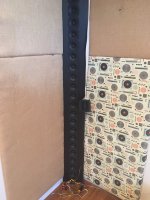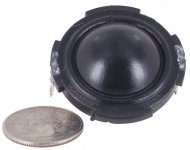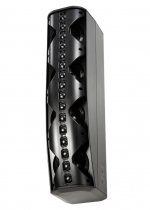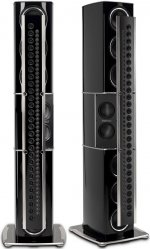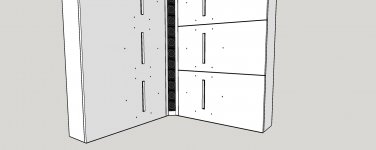Hello all,
first an apology - I've not read all of this thread yet as I pass occasionally through DIYaudio.com.
This is more a question as to whether I should try and catch up on all the reading here and on the original thread.
Issue: I've got a narrow room where I was hoping to use Open Baffle speakers based on Beyma TPL-150's with Visaton B200's. I originally bought this setup after reading the threads about the B200 and have had them running with some 15" bass drivers with success. However, with a girlfriend and the possibility of a baby in the future, having the space for OB speakers is quickly diminishing.
So, will a line array suit my room?
I have a 10m by 3.6m lounge with a stairwell in the middle. I will have a floor to ceiling bookshelf on one end of the room and I was thinking about building the line array into the outside sides of the bookshelf.
Might that be a good compromise?
first an apology - I've not read all of this thread yet as I pass occasionally through DIYaudio.com.
This is more a question as to whether I should try and catch up on all the reading here and on the original thread.
Issue: I've got a narrow room where I was hoping to use Open Baffle speakers based on Beyma TPL-150's with Visaton B200's. I originally bought this setup after reading the threads about the B200 and have had them running with some 15" bass drivers with success. However, with a girlfriend and the possibility of a baby in the future, having the space for OB speakers is quickly diminishing.
So, will a line array suit my room?
I have a 10m by 3.6m lounge with a stairwell in the middle. I will have a floor to ceiling bookshelf on one end of the room and I was thinking about building the line array into the outside sides of the bookshelf.
Might that be a good compromise?
Your room certainly appears to be big enough. How tall is it? With the arrays though, you would have to sit at least one array height away from the array. If you can do that, you should be fine.
Sorry for the delay in responding... been busy running around with other stuff.
Sorry for the delay in responding... been busy running around with other stuff.
Having a few unfinished projects (as always  ) and less money than always I decided not to build LA yet.
) and less money than always I decided not to build LA yet.
Perhaps this will be useful to someone: Vifa TG9FD10-04 3.5" Full Range
$9 for TG9!
At the end of last year they had "enough" in the factory boxes, 24pcs in box.
Perhaps this will be useful to someone: Vifa TG9FD10-04 3.5" Full Range
$9 for TG9!
At the end of last year they had "enough" in the factory boxes, 24pcs in box.
I wanted the drivers to be as close to the wall corner as possible and so that limited how wide the cabinet could be. And it was always going to be 7'-0" tall, the height of the ceiling. The cabinet dimensions sort of limit the bass extension. I can throw power at it and get it flat, but I am not doing that because I use a separate sub and am building two more at the moment. Besides, the resonant frequency of the TC9 is 125 Hz and it may not be a good idea to push it much below that region.
The measurement is made at the couch, just below and behind the projector. It is more than 12 feet away from the speaker. The HF has a 6 db boost past 4 kHz in all the uncorrected measurements. The uncorrected measurements show a pretty impressive impulse response. It is almost the perfect Dirac pulse. But one would expect that given the even frequency and nearly flat phase.
The uncorrected measurements are fed to DRC and the corrected response is convolved through JRiver. The corrected impulse does show some ringing. I suspect it is related to the measurement setup, or it could be that the subwoofer kicks in much before the array. Needs some investigating.
Uncorrected Left FR and phase:
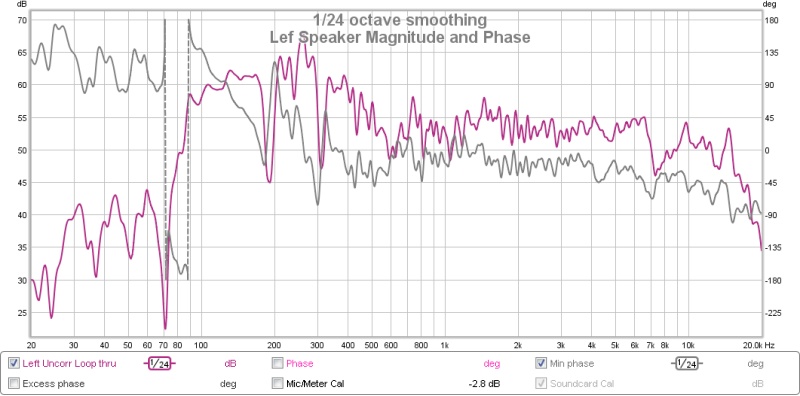
Uncorrected Right FR and phase:
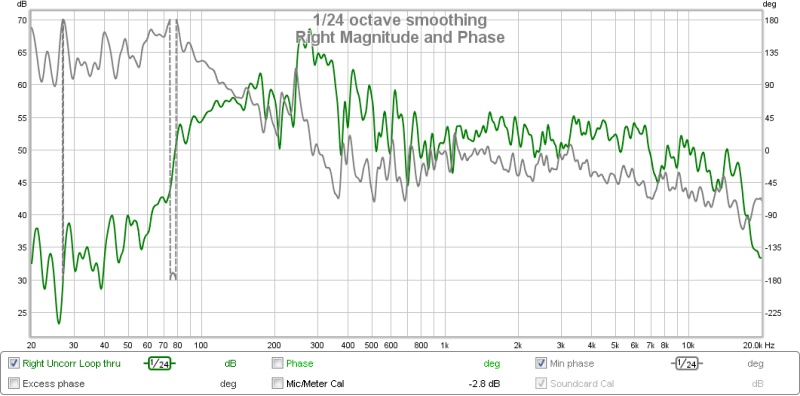
Uncorrected impulse response:
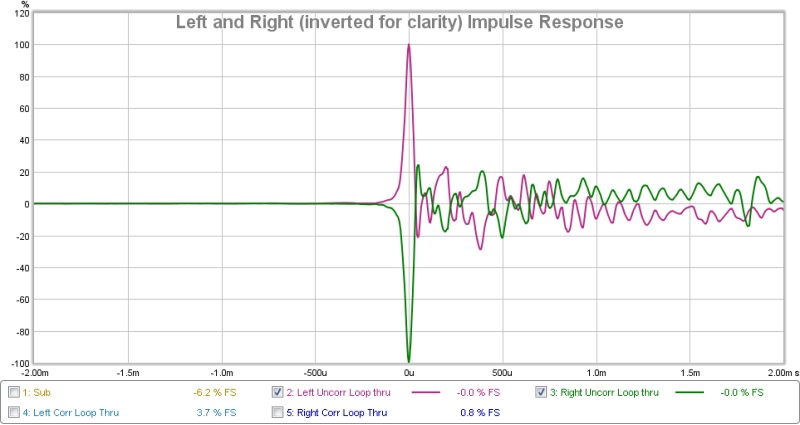
Corrected impulse response:
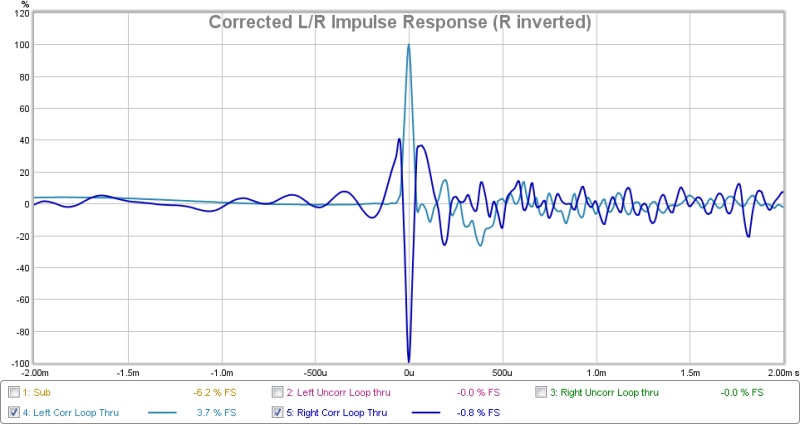
Corrected FR with sub 1/48th Octave smoothing:
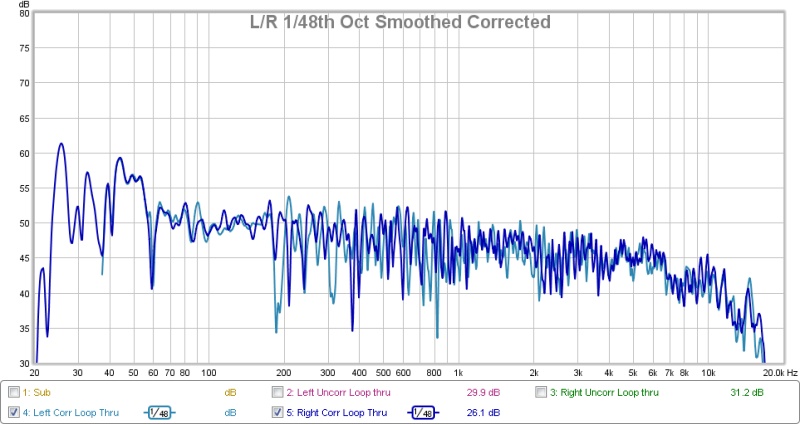
Corrected FR with sub ERB smoothing in REW:
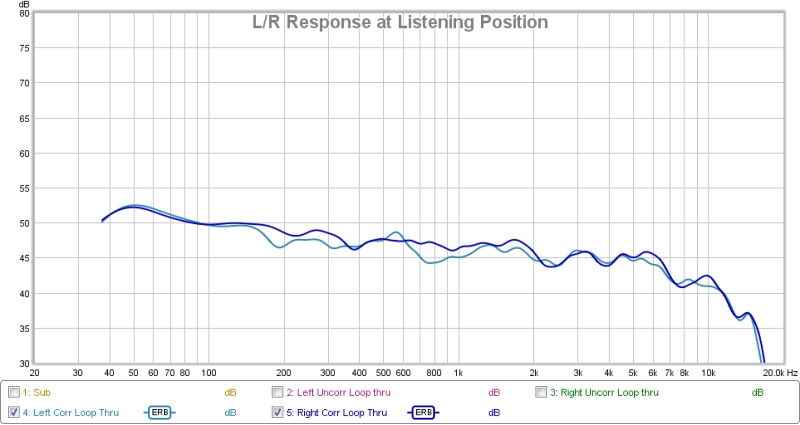
Question-
According to the first two graphs (L+R uncorrected FR and phase), the magenta and green lines are as phase correct?
And the gray lines are FR?
Seems hard to believe (in such a tiny enclosure) the FR has such deep bass extension past the TC9's Fs, (125).
Even PE's Bass Box 6 recommended .1'cubic ft. enclosure has an F3 of 122Hz.
I estimated (perhaps incorrectly) the volume of each woofer at 1/10th of that,
at approx. .01'cubic feet.
Is it really the corner loading, or am I backwards on the gray lines being FR and not phase??
Apologies as I'm quite illiterate when it comes to reading graphs..
magenta and green are FR so there isn't as much bass extension as you thought. (look at the bottom of the graphs for color interpretation)
Even so, the small box means the uncorrected response needs more bass boost and more power to get up to what you see in a final graph, than would be the case with a larger cabinet (as recommended by Bass Box, e.g.)
Corner loading does help but only down to a point, lower with concrete walls than conventional frame construction, which in my experience is only good to 30 or 40 hz.
Even so, the small box means the uncorrected response needs more bass boost and more power to get up to what you see in a final graph, than would be the case with a larger cabinet (as recommended by Bass Box, e.g.)
Corner loading does help but only down to a point, lower with concrete walls than conventional frame construction, which in my experience is only good to 30 or 40 hz.
Thank you.
I was Pondering over (corner) enclosure sizes for a bunch of TC9’s.
I like ra’s idea of trying to keep the drivers as tightly in the corners as possible.
Saving space, and perhaps eliminating some problematic early reflections.
I will also be using a couple of subs so I suppose it’s a FAST or WAW design lol.
I was Pondering over (corner) enclosure sizes for a bunch of TC9’s.
I like ra’s idea of trying to keep the drivers as tightly in the corners as possible.
Saving space, and perhaps eliminating some problematic early reflections.
I will also be using a couple of subs so I suppose it’s a FAST or WAW design lol.
Yes, build as tight as you can into corner. even better, line the corner with rigid fiberglass or other absorber and fit the LA tight to that.
plan angle of baffle across corner so you sit within +/- 10 degrees of on-axis to get best treble
the recommended volume for TC9s is fairly high. when going well below recommended volume best to check power requirements for your bass boost. HornResp simulation is good for that.
plan angle of baffle across corner so you sit within +/- 10 degrees of on-axis to get best treble
the recommended volume for TC9s is fairly high. when going well below recommended volume best to check power requirements for your bass boost. HornResp simulation is good for that.
A significant update
Hi All! Hope you are all doing great. Life has been busy. I've moved a couple of times, and haven't really made any big changes to the array. Mostly just playing with different target curves and DRC settings. I've settled on a recipe that produces very neutral sound. It involves using a vector averaged measurement in REW and then adjusting the target to account for the reduction in level in the HF in the vector averaged curve.
One thing that has always bothered me is the HF response of the array. Above 3 kHz, the drive units are too far apart and the individual units do not add coherently. This shows up in the measurements as combing beginning about 3 kHz. The theory was that it wouldn't matter too much because there are so many units and there is never perfect cancellation at any particular frequency--the other units would fill in some of it. Also, if you move your head, and research has shown that you do so unconsciously, then the comb filtering effect is much reduced through averaging. In listening, this resulted in good timbre but somewhat hazy imaging compared to, say, the Altec VOTTs that I've owned in the past.
The obvious fix is to use a small array of drivers with smaller diaphragms, i.e., tweeters, that could operate in the HF. There are several examples of commercial arrays with a full length of tweeters. The array need not be that long. If 3 kHz was the start frequency, then it only needed to be about 4.5 inches long to control vertical directivity at that frequency. I had some time alone to myself and unfettered access to the listening room, so, I decided to give it a go.
I didn't have small tweeters on hand but I had the Fountek Neo3.5H ribbon tweeter. I had bought it some time ago to support the HF section of the Inlow horn. So, I suspended it from the top of the array at about ear height, sitting next to the TC9, and connected it to a 3rd order crossover for 3 kHz and started measuring. For the arrays, turning off the HF boost results in a nice rolloff by itself, but to hit 3 kHz, I added a second order filter. It was summing nicely without doing much else--a bit surprising really. Anyway, I pushed it through DRC with the usual settings and that produced a nice smooth response.
Upon first listen, the first thing to notice was that the Neo3.5H ribbons are quite directional and produced a dry sound compared to the array by itself, which, obviously, puts out a lot more reflected HF energy. Further listening revealed that adding a tweeter was a really good idea.
The Neo3.5H is a superb driver when kept within its limits. It unearthed so many nuances and tone colors (to borrow Lynn Olson's phrase). Each instrument in each track suddenly had a distinct sound and tuning. The differences in two side by side woodwind instruments became so much starker. The unique resonances of different instruments, pianos in particular, could be much more easily heard and enjoyed. You could also identify different playing styles of different people. It suddenly sounds like it is not instruments playing themselves but people playing the instruments.
And the imaging has improved too. It is much more stable, precise. There was always good depth but the layers are now more clearly established. You are very much there, whether it is a church acoustic, or a symphony hall, or a studio. There is less effort required for the suspension of disbelief.
What are the downsides? It sounds harsh on some crescendos, where earlier with the full array, it felt like it had infinite headroom, albeit with less definition than the ribbon. Also, it sounds different when you stand up.
I want to play some more and make a better effort at implementing a tweeter array. So, I ordered 10 Vifa OC25SC65-04, which are 1" textile dome tweeters. I was looking for something that would:
--allow me to mount the drivers as close together as possible,
--have shallow depth so that it doesn't stick out as much as the Neo3.5H from the front of the array,
--omni up to a highest possible frequency for good summing in the array,
--reasonably low Fs, so as to begin operating it at 2-2.5 kHz,
--and be cheap.
As a bonus, this is a Vifa driver to complement the Vifa TC9 (keepin' it in the family).
Planning to make it a 5-element array and have the outer four elements roll-off starting around 7 or 8 kHz and just have the central element operate from 8 kHz or so to 20 kHz to stay out of combing. Let's see how this goes.
This new topology of using a smaller tweeter array is sort of getting closer to David Smith's expanding array or even the Dunlavy SC VI and maybe that is the optimum topology. I actually had a chance to listen to the Dunlavy SC VI at one of my audiophile friend's place. Hands down the best speaker I've ever heard. Simply perfect perfect tonal balance and imaging.
Hi All! Hope you are all doing great. Life has been busy. I've moved a couple of times, and haven't really made any big changes to the array. Mostly just playing with different target curves and DRC settings. I've settled on a recipe that produces very neutral sound. It involves using a vector averaged measurement in REW and then adjusting the target to account for the reduction in level in the HF in the vector averaged curve.
One thing that has always bothered me is the HF response of the array. Above 3 kHz, the drive units are too far apart and the individual units do not add coherently. This shows up in the measurements as combing beginning about 3 kHz. The theory was that it wouldn't matter too much because there are so many units and there is never perfect cancellation at any particular frequency--the other units would fill in some of it. Also, if you move your head, and research has shown that you do so unconsciously, then the comb filtering effect is much reduced through averaging. In listening, this resulted in good timbre but somewhat hazy imaging compared to, say, the Altec VOTTs that I've owned in the past.
The obvious fix is to use a small array of drivers with smaller diaphragms, i.e., tweeters, that could operate in the HF. There are several examples of commercial arrays with a full length of tweeters. The array need not be that long. If 3 kHz was the start frequency, then it only needed to be about 4.5 inches long to control vertical directivity at that frequency. I had some time alone to myself and unfettered access to the listening room, so, I decided to give it a go.
I didn't have small tweeters on hand but I had the Fountek Neo3.5H ribbon tweeter. I had bought it some time ago to support the HF section of the Inlow horn. So, I suspended it from the top of the array at about ear height, sitting next to the TC9, and connected it to a 3rd order crossover for 3 kHz and started measuring. For the arrays, turning off the HF boost results in a nice rolloff by itself, but to hit 3 kHz, I added a second order filter. It was summing nicely without doing much else--a bit surprising really. Anyway, I pushed it through DRC with the usual settings and that produced a nice smooth response.
Upon first listen, the first thing to notice was that the Neo3.5H ribbons are quite directional and produced a dry sound compared to the array by itself, which, obviously, puts out a lot more reflected HF energy. Further listening revealed that adding a tweeter was a really good idea.
The Neo3.5H is a superb driver when kept within its limits. It unearthed so many nuances and tone colors (to borrow Lynn Olson's phrase). Each instrument in each track suddenly had a distinct sound and tuning. The differences in two side by side woodwind instruments became so much starker. The unique resonances of different instruments, pianos in particular, could be much more easily heard and enjoyed. You could also identify different playing styles of different people. It suddenly sounds like it is not instruments playing themselves but people playing the instruments.
And the imaging has improved too. It is much more stable, precise. There was always good depth but the layers are now more clearly established. You are very much there, whether it is a church acoustic, or a symphony hall, or a studio. There is less effort required for the suspension of disbelief.
What are the downsides? It sounds harsh on some crescendos, where earlier with the full array, it felt like it had infinite headroom, albeit with less definition than the ribbon. Also, it sounds different when you stand up.
I want to play some more and make a better effort at implementing a tweeter array. So, I ordered 10 Vifa OC25SC65-04, which are 1" textile dome tweeters. I was looking for something that would:
--allow me to mount the drivers as close together as possible,
--have shallow depth so that it doesn't stick out as much as the Neo3.5H from the front of the array,
--omni up to a highest possible frequency for good summing in the array,
--reasonably low Fs, so as to begin operating it at 2-2.5 kHz,
--and be cheap.
As a bonus, this is a Vifa driver to complement the Vifa TC9 (keepin' it in the family).
Planning to make it a 5-element array and have the outer four elements roll-off starting around 7 or 8 kHz and just have the central element operate from 8 kHz or so to 20 kHz to stay out of combing. Let's see how this goes.
This new topology of using a smaller tweeter array is sort of getting closer to David Smith's expanding array or even the Dunlavy SC VI and maybe that is the optimum topology. I actually had a chance to listen to the Dunlavy SC VI at one of my audiophile friend's place. Hands down the best speaker I've ever heard. Simply perfect perfect tonal balance and imaging.
Attachments
Last edited:
I've been playing with the 3.5 a bit, and I have found that keeping off the vertical axis helps a lot.
Try them between sitting and standing ear height, and let me know what you think.
I am eight to ten feet away when sitting. How far is your listening position?
Try them between sitting and standing ear height, and let me know what you think.
I am eight to ten feet away when sitting. How far is your listening position?
Last edited:
At times I'd wish we all lived closer to each other  , would love to sit in and have a listen.
, would love to sit in and have a listen.
I've often thought of an experiment like this myself, but most probably I'm not an average DIYaudio guy, as I don't have spare drivers or even amps I could use .
.
I'm quite curious how this will pan out, if you can add an array of tweeters while keeping the seamless presentation of the full range arrays.
I agree that the work from Dunlavy made a lot of sense, though I'd wish we could use a line of drivers for low mid and bass that was more seamless. That's why I've mentioned a synergy like approach within a line of drivers a few times as a valid candidate. It would occupy way more space though, but the Synergy would be a way to get a real close spacing of the tweet and mids, while also being capable of going lower in frequency to hand over to (and join) an array above and below it. Sort of a Dunlavy on steroids or a seamless expanding array. First time I thought of that was the A Bookshelf Multi-Way Point-Source Horn thread, showing it could reach quite low (as to still being able to be part of a larger array).
I do think it would ideally need a horn with larger coverage though.
I've often thought of an experiment like this myself, but most probably I'm not an average DIYaudio guy, as I don't have spare drivers or even amps I could use
I'm quite curious how this will pan out, if you can add an array of tweeters while keeping the seamless presentation of the full range arrays.
I agree that the work from Dunlavy made a lot of sense, though I'd wish we could use a line of drivers for low mid and bass that was more seamless. That's why I've mentioned a synergy like approach within a line of drivers a few times as a valid candidate. It would occupy way more space though, but the Synergy would be a way to get a real close spacing of the tweet and mids, while also being capable of going lower in frequency to hand over to (and join) an array above and below it. Sort of a Dunlavy on steroids or a seamless expanding array. First time I thought of that was the A Bookshelf Multi-Way Point-Source Horn thread, showing it could reach quite low (as to still being able to be part of a larger array).
I do think it would ideally need a horn with larger coverage though.
Very interesting but I don't think combing is the whole story and maybe not even the biggest part of it. In addition to reduced combing you get better treble dispersion and reduced modulation distortion.. Sweet spot is improved but but standing listening suffers. Which of those benefits is really responsible for the perceived improvement?
Yeah, the only array I get to listen to is my own. That is probably good because if I heard either of yours I'd likely be compelled to work harder on mine or my room.At times I'd wish we all lived closer to each other, would love to sit in and have a listen.
I'm quite curious how this will pan out, if you can add an array of tweeters while keeping the seamless presentation of the full range arrays.
How important is the high end? Is it worth a line of tweeters or should we look at smaller full range drivers? This might be a question that one might have to build something to answer.
My arrays sometimes disappoint me on crescendos so I've been thinking about companion bass tower to offload it below 200 Hz instead of at100 Hz to subs as now. Or I could build a new array using 1.5" Dayton DMA45 and that same/similar bass tower and more robust cabinet construction.
That Dayton looks like a tweeter that extends below 200 Hz in an array. I bought a couple and measured them but didn't do any listening with them. But that kind of low end response from a tweeter is enabling.
I also did a Vituix model of sim of a line the economical Dayton PTmini planar tweeter next to a line of TC9s. On paper it worked well. Modeled a near brick wall crossover to the tweeter array because of the spacing and the only polar response anomaly was a response narrowing in a very narrow region around the XO.
Several interesting directions this could be taken.
I can agree on the doubts about combing being the culprit. However I am surprised to read your crescendos not being up to par (yet). I'd think the drivers still are loafing around there, provided they have enough room to breathe in the enclosure.
I don't fully rely on DRC-FIR alone to get my top end up to par, I've always done manual tweaks afterwards to get it to sound as good as I could. Lots of work but well worth it. Especially going over the range from 5K to about ~8K makes a lot of difference in imaging quality. Little tweaks can make quite remarkable perceptual differences.
This way I can get it quite satisfactory despite the onset of combing in this range and this has made me in no hurry to do any tweeter experiments myself, as that opens up a lot of other potential problems.
Ideally you'd want (or at least I would) coax mounting of the tweeter array, impossible to do without it's own drawbacks. Even though examples do exist from JBL and McIntosh.
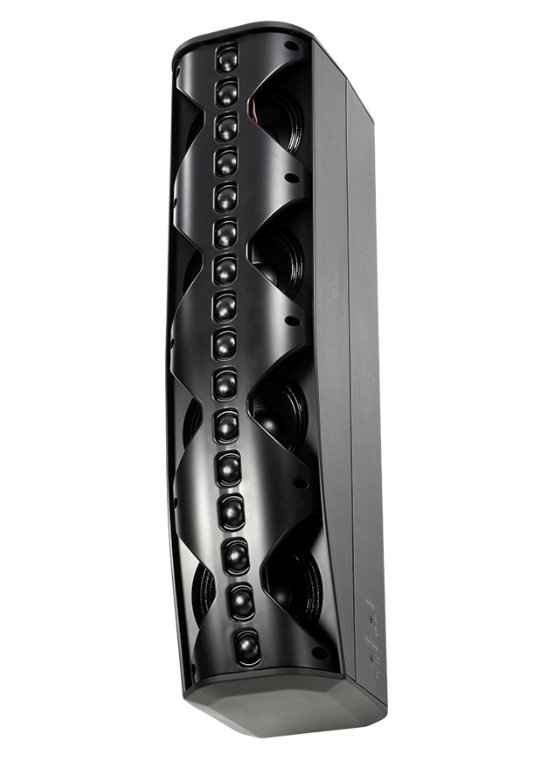
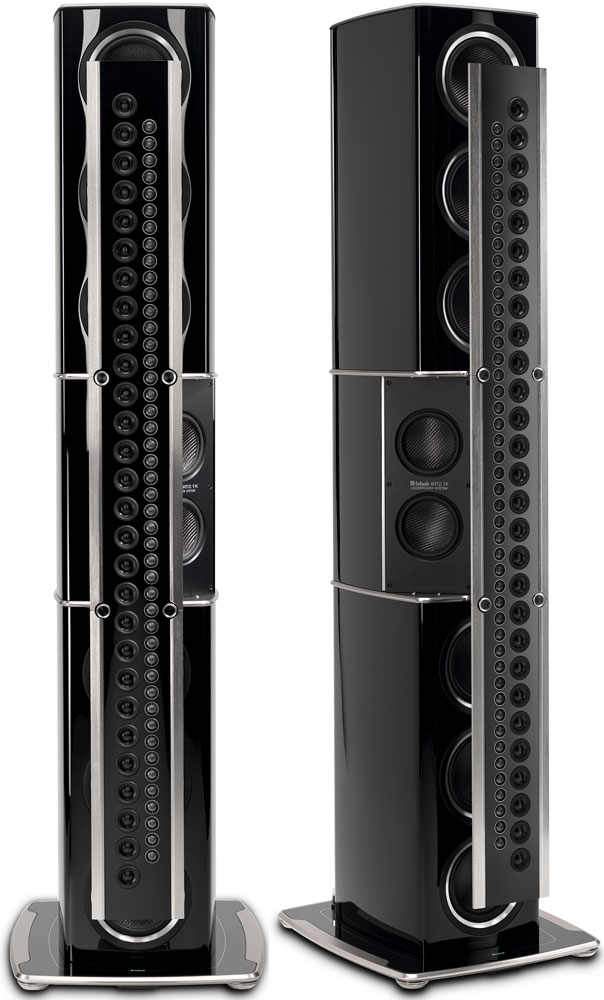
(JBL on left, McIntosh on right)
The JBL (it's a CBT using DSP) still has relatively large tweeter spacing, but also uses shading to help it out, the McIntosh still has a side by side array arrangement and this particular model has some other tricks as well.
But all this above is going to cause diffraction, which I'd like to avoid as much as possible (for imaging reasons!). Side by side lines doesn't have my preference. I've also thought about using shading only on the higher frequencies which should work too (frequency dependent, making it an expanding array by using more and more drivers, the lower you go).
However as said, I currently don't feel the need for it. I can get accurate (believable) enough imaging to not want to go there. I can't complain about my top end. With mid/side tweaks and ambient speakers I'm pretty much where I want to be. Head shaking and moving included .
.
There's so many factors here to play with that I'm sure I haven't even scratched the surface yet. I'm still chasing the things I did hear in earlier experiments and try to combine each facet of it that I liked. I'm getting closer gradually but sometimes missing it too (getting it to sound worse does happen to me too ).
).
So I won't give up on the fullrange idea any time soon, though the sub addition has been fun to try. Maybe one day I'l start playing with tweeters, be it ambient or as a real tweeter function or something else entirely.
Prior to koldby/BYRRT's visit that was dedicated to us testing amplifiers, I never thought how much that could influence what we hear. I bought into the: "an amplifier is an amplifier and if it measures the same it will sound the same" line of thought. Nowadays I do get that this particular difference isn't all that easy to spot in FR measurements alone. Even though the differences do exist I have yet to find them with assurance. I'm actually still trying to get the Goldmund to do a couple of things that I did have with the Pioneer. The FR curve corrected to being (exactly) the same did not solve that part of my puzzle.
As an example; it is quite clear that the Goldmund has way better channel separation (probably due to being a dual mono construction), even though I had assumed this difference to fall way below anything we could actually spot in a real room with a real noise floor covering details like that.
However this tweak ra7 is trying right now is always a worthwhile experiment. We may all learn from it.
I don't fully rely on DRC-FIR alone to get my top end up to par, I've always done manual tweaks afterwards to get it to sound as good as I could. Lots of work but well worth it. Especially going over the range from 5K to about ~8K makes a lot of difference in imaging quality. Little tweaks can make quite remarkable perceptual differences.
This way I can get it quite satisfactory despite the onset of combing in this range and this has made me in no hurry to do any tweeter experiments myself, as that opens up a lot of other potential problems.
Ideally you'd want (or at least I would) coax mounting of the tweeter array, impossible to do without it's own drawbacks. Even though examples do exist from JBL and McIntosh.
(JBL on left, McIntosh on right)
The JBL (it's a CBT using DSP) still has relatively large tweeter spacing, but also uses shading to help it out, the McIntosh still has a side by side array arrangement and this particular model has some other tricks as well.
But all this above is going to cause diffraction, which I'd like to avoid as much as possible (for imaging reasons!). Side by side lines doesn't have my preference. I've also thought about using shading only on the higher frequencies which should work too (frequency dependent, making it an expanding array by using more and more drivers, the lower you go).
However as said, I currently don't feel the need for it. I can get accurate (believable) enough imaging to not want to go there. I can't complain about my top end. With mid/side tweaks and ambient speakers I'm pretty much where I want to be. Head shaking and moving included
There's so many factors here to play with that I'm sure I haven't even scratched the surface yet. I'm still chasing the things I did hear in earlier experiments and try to combine each facet of it that I liked. I'm getting closer gradually but sometimes missing it too (getting it to sound worse does happen to me too
So I won't give up on the fullrange idea any time soon, though the sub addition has been fun to try. Maybe one day I'l start playing with tweeters, be it ambient or as a real tweeter function or something else entirely.
Prior to koldby/BYRRT's visit that was dedicated to us testing amplifiers, I never thought how much that could influence what we hear. I bought into the: "an amplifier is an amplifier and if it measures the same it will sound the same" line of thought. Nowadays I do get that this particular difference isn't all that easy to spot in FR measurements alone. Even though the differences do exist I have yet to find them with assurance. I'm actually still trying to get the Goldmund to do a couple of things that I did have with the Pioneer. The FR curve corrected to being (exactly) the same did not solve that part of my puzzle.
As an example; it is quite clear that the Goldmund has way better channel separation (probably due to being a dual mono construction), even though I had assumed this difference to fall way below anything we could actually spot in a real room with a real noise floor covering details like that.
However this tweak ra7 is trying right now is always a worthwhile experiment. We may all learn from it.
Attachments
re' crescendos hot up to par
the drivers have a bare minimum of breathing room and the walls are too thin. I recently realized that the walls are radiating albeit directly into absorbers. I think I want to beef them up before I do anything else.
Here is what I'm thinking for a 2-way array
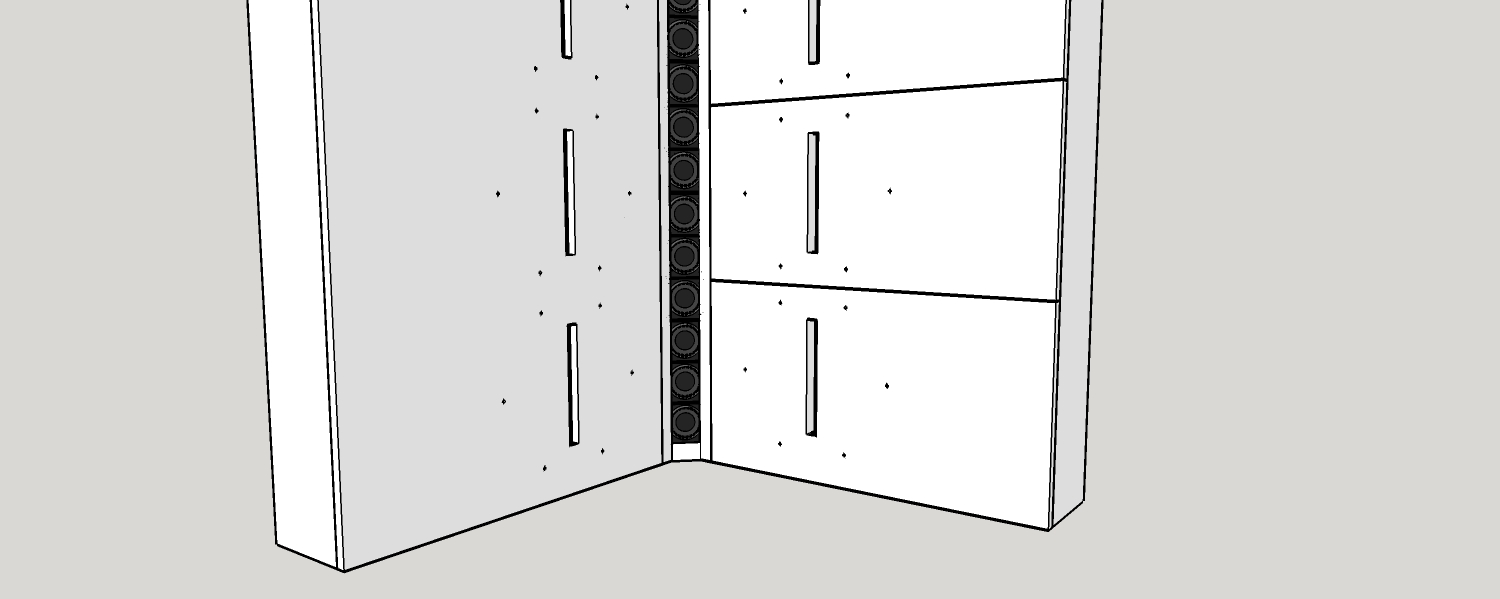
with the DMA-45, the apex of the V need only be 1.3" wide
the drivers have a bare minimum of breathing room and the walls are too thin. I recently realized that the walls are radiating albeit directly into absorbers. I think I want to beef them up before I do anything else.
Here is what I'm thinking for a 2-way array
with the DMA-45, the apex of the V need only be 1.3" wide
Attachments
I didn't need bass because it was a 2 way array. I was chose the DMA45 for its wider dispersion. With the array built into the corner, you can't really aim it at the LP as you would with a larger driver that beamed in the HF. This far down the road, I'm not so sure about the DMA45 in that regard but it would be a lot better than a TC9 or even the 2.5" Dayton ND64.
Last edited:
- Home
- Loudspeakers
- Multi-Way
- Corner Floor-to-Ceiling Line Array Using Vifa TC9

 in front wall, infinite baffle in any case.
in front wall, infinite baffle in any case.